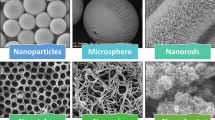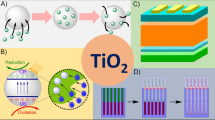Abstract
Although TiO2 is used in a wide range of photocatalytic applications, its activity can be improved considerably by coupling with a metal oxide, such as WO3, in a bicomponent systems. However, the amount of WO3 deposited onto TiO2 is of crucial importance because it may influence the optical and electrochemical properties and, consequently, the photocatalytic activity. In the present study, a series of modified electrodes were prepared by electrochemical deposition of different amounts of WO3 onto TiO2 nanotubes (TiO2-NTs). Energy dispersive X-ray analysis revealed that increasing amounts of W were deposited with increased deposition times between 5 and 60 min, and that electrodes EW5, EW10, EW15, EW30, EW45, and EW60 contained 0.74, 1.27, 1.60, 4.85, 10.10, and 13.30 at.% W, respectively. X-ray diffraction patterns confirmed the presence of the WO3 crystalline phase and the TiO2 anatase. Diffuse reflectance spectra of electrodes EW5, EW10, and EW15 exhibited the most intense absorbances, and their energy band-gap values were in the region of 2.90 eV, which is comparable with the value for TiO2-WO3 bicomponent. The photoactivities of electrodes EW5 and EW10 containing low amounts of W (~1 %) exhibited photocurrents that were, respectively, 13 and 25 % higher than that of the unmodified TiO2-NTs electrode. Electrodes containing larger amounts of W showed correspondingly reduced photocurrents. The application of electrodes E0 and EW10 on the photoelectrocatalytic oxidation of Bisphenol-A (BPA) revealed excellent removal rate which BPA was not detected after 30 min of reaction. The electrode EW10 achieved ~64 % of total organic carbon (TOC) in the end of degradation, more effective compared to the electrode E0 (58 %). These findings demonstrate that photoelectrocatalytic efficiency is strictly dependent on morphology and amount of WO3. Optimal deposition of WO3 favors the formation of WO3-TiO2 heterojunctions, thereby improving the performance of the semiconductor.

ᅟ







Similar content being viewed by others
References
C. Comninellis, A. Kapalka, S. Malato, S. A. Parsons, L. Poulios, D. Mantzavinos, Advanced oxidation processes for water treatment: advances and trends for R&D. J. Chem. Technol. Biotechnol. 83, 769 (2008)
S. Malato, P. Fernández-Ibáñez, M. I. Maldonado, J. Blanco, W. Gernjak, Decontamination and disinfection of water by solar photocatalysis: recent overview and trends. Catal. Today 147, 1 (2009)
D. Mantzavinos, E. Psillakis, Enhancement of biodegradability of industrial wastewaters by chemical oxidation pre-treatment. J. Chem. Technol. Biotechnol. 79, 431 (2004)
J. Georgieva, E. Valova, S. Armyanov, N. Philippidis, I. Poulios, S. Sotiropoulos, Bi-component semiconductor oxide photoanodes for the photoelectrocatalytic oxidation of organic solutes and vapours: a short review with emphasis to TiO2-WO3 photoanodes. J. Hazard. Mater. 211-212, 30 (2012)
K. Rajeshwar, N. R. De Tacconi, C. R. Chenthamarakshan, Semiconductor-based composite materials: preparation, properties, and performance. Chem. Mater. 13, 2765 (2001)
D. F. Ollis, E. Pelizzetti, N. Serpone, Photocatalyzed destruction of water contaminants. Environ. Sci. Technol. 25, 1522 (1991)
X. Chen, S. S. Mao, Titanium dioxide nanomaterials: synthesis, properties, modifications, and applications. Chem. Rev. 107, 2891 (2007)
A. Fujishima, X. Zhang, D. A. Tryk, TiO2 photocatalysis and related surface phenomena. Surf. Sci. Rep. 63, 515 (2008)
G. K. Mor, O. K. Varghese, M. Paulose, K. Shankar, C. A. Grimes, A review on highly ordered, vertically oriented TiO2 nanotube arrays: fabrication, material properties, and solar energy applications. Sol. Energ. Mat. Sol. Cells 90, 2011 (2006)
S. H. Kang, J.-Y. Kim, H. S. Kim, Y.-E. Sung, Formation and mechanistic study of self-ordered TiO2 nanotubes on Ti substrate. J. Ind. Eng. Chem. 14, 52 (2008)
N. Serpone, Is the band gap of pristine TiO2 narrowed by anion- and cation-doping of titanium dioxide in second-generation photocatalysts? J. Phys. Chem. B 110, 24287 (2006)
H. J. Zhang, G. H. Chen, D. W. Bahnemann, Photoelectrocatalytic materials for environmental applications. J. Mater. Chem. 19, 5089 (2009)
J. Georgieva, TiO2/WO3 photoanodes with enhanced photocatalytic activity for air treatment in a polymer electrolyte cell. J. Solid State Electrochem. 16, 1111 (2012)
E. L. Yang, J. J. Shi, H. C. Liang, W. K. Cheuk, Coaxial WO3/TiO2 nanotubes/nanorods with high visible light activity for the photodegradation of 2,3-dichlorophenol. Chem. Eng. J. 174, 539 (2011)
N. A. Ramos-Delgado, M. A. Gracia-Pinilla, L. Maya-Treviño, L. Hinojosa-Reyes, J. L. Guzman-Mar, A. Hernández-Ramírez, Solar photocatalytic activity of TiO2 modified with WO3 on the degradation of an organophosphorus pesticide. J. Hazard. Mater. 263, 36 (2013)
C. Santato, M. Odziemkowski, M. Ulmann, J. Augustynski, Crystallographically oriented mesoporous WO3 films: synthesis, characterization, and applications. J. Am. Chem. Soc. 123, 10639 (2001)
K. K. Akurati, A. Vital, J. P. Dellemann, K. Michalow, T. Graule, D. Fetti, A. Baiker, Flame-made WO3/TiO2 nanoparticles: relation between surface acidity, structure and photocatalytic activity. Appl. Catal. B. 79, 53 (2008)
Y. Xin, M. Gao, Y. Wang, D. Ma, Photoelectrocatalytic degradation of 4-nonylphenol in water with WO3/TiO2 nanotube array photoelectrodes. Chem. Eng. J. 242, 162 (2014)
S. A. Singh, G. Madras, Photocatalytic degradation with combustion synthesized WO3 and WO3-TiO2 mixed oxides under UV and visible light. Sep. Purif. Technol. 105, 79 (2013)
A. Ghicov, B. Schmidt, J. Kunze, P. Schmuki, Photoresponse in the visible range from Cr doped TiO2 nanotubes. Chem. Phys. Lett. 433, 323 (2007)
N. R. De Tacconi, C. R. Chenthamarakshan, K. Rajeshwar, T. Pauporte, D. Lincot, Pulsed electrodeposition of WO3-TiO2 composite films. Electrochem. Commun. 5, 220 (2003)
R. Asahi, T. Morikawa, T. Ohwaki, K. Aoki, Y. Taga, Visible-light photocatalysis in nitrogen-doped titanium oxides. Science 293, 269 (2001)
S. Perathoner, R. Passalacqua, G. Centi, D. S. Su, G. Weinberg, Photoactive titania nanostructured thin films: synthesis and characteristics of ordered helical nanocoil array. Catal. Today 122, 3 (2007)
J. Tauc, R. Grigorov, A. Vancu, Optical properties and electronic structure of amorphous germanium. Phys. Status Solidi 15, 627 (1966)
A. A. Christy, O. M. Kvalheim, R. A. Velapoldi, Quantitative analysis in diffuse-reflectance spectrometry—a modified Kubelka-Munk equation. Vib. Spectrosc. 9, 19 (1995)
R. López, R. Gómez, Band-gap energy estimation from diffuse reflectance measurements on sol-gel and commercial TiO2: a comparative study. J. Sol-Gel Sci. Technol. 61, 1 (2012)
J. Georgieva, S. Armyanov, E. Valova, I. Poulios, S. Sotiropoulos, Enhanced photocatalytic activity of electrosynthesised tungsten trioxide -titanium dioxide bi-layer coatings under ultraviolet and visible light illumination. Electrochem. Commun. 9, 365 (2007)
K. I. Liu, Y. C. Hsueh, C. Y. Su, T. P. Perng, Photoelectrochemical application of mesoporous TiO2/WO3 nanohoneycomb prepared by sol-gel method. Int. J. Hydrogen Energ. 38, 7750 (2013)
H. Sun, B. Dong, G. Su, R. Gao, W. Liu, L. Song, L. Cao, Modification of TiO2 nanotubes by WO3 species for improving their photocatalytic activity. Appl. Surf. Sci. 343, 181 (2015)
Acknowledgments
The authors gratefully acknowledge the support of the Fundação de Amparo à Pesquisa do Estado de São Paulo (FAPESP; grant no. 2013/08543-3 and 2015/08815-9) and the Conselho Nacional de Desenvolvimento Científico e Tecnológico (CNPq).
Author information
Authors and Affiliations
Corresponding authors
Rights and permissions
About this article
Cite this article
Martins, A.S., Cordeiro-Junior, P.J.M., Nuñez, L. et al. A Simple Method for the Electrodeposition of WO3 in TiO2 Nanotubes: Influence of the Amount of Tungsten on Photoelectrocatalytic Activity. Electrocatalysis 8, 115–121 (2017). https://doi.org/10.1007/s12678-016-0335-9
Published:
Issue Date:
DOI: https://doi.org/10.1007/s12678-016-0335-9




